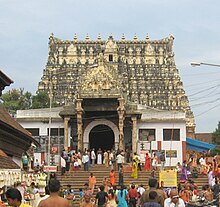Padmanabhaswamy Temple
The Padmanabhaswamy Temple is a Hindu temple in Thiruvananthapuram (Trivandrum), the capital of the southern Indian state of Kerala . He is dedicated to Padmanabha ("he with the lotus button"), a manifestation of the god Vishnu . The temple was built at the end of the 18th century by the Kings of Travancore , who resided in Thiruvananthapuram and worshiped Padmanabha as their family deity. The Padmanabhaswamy Temple is one of 108 holy places ( Divya Desams ) of the South Indian Vishnuism .
description
The Padmanabhaswamy Temple is located inside the former fort (Fort city) in the southwest of Thiruvananthapuram. In front of the temple is the temple pond known as Padma Tirtham . In the immediate vicinity of the temple is the Puttan Malika Palace , the former residence of the rulers of Travancore. The most striking architectural feature of the Padmanabhaswamy Temple is the 17 meter high seven-story gopuram (gate tower) in the Dravida style . In the Holy of Holies ( Garbhagriha ) there is an image of a god, which Vishnu represents resting on the mythical serpent Ananta (Shesha). Thiruvananthapuram ("Holy City of Anantas") owes its name to this very snake. Admission to the Padmanabhaswamy Temple is subject to strict restrictions, as is usual in Kerala: Male temple visitors are only allowed to enter the temple with a bare chest and a dhoti as trousers. Entry is completely prohibited for non-Hindus.
Treasure find
After the royal family of Travancore , who previously owned the temple, could no longer pay for the upkeep of the sanctuary, the Supreme Court in New Delhi ordered the transfer of the temple to the state of Kerala in 2011, against the opposition of the royal family. In a subsequent inventory on June 30, 2011, large quantities of diamonds, rubies, emeralds, 536 kilograms of gold coins from the 18th century and numerous artifacts were found in basement rooms that had been locked for at least 130 years. According to initial estimates, the material value alone is over 15 billion euros. The Indian government has initially assigned two dozen police officers to guard the temple around the clock. Oommen Chandy , the chief minister of Kerala, announced that the state has no claims on the finds that he believes are the property of the temple. After the inventory and determination of the total value (among other things, two further chambers have not yet been opened), which experts believe will take months, the Supreme Court of India will determine what should be done with the temple treasures.
The more than 380 larger and 1,123 smaller temple treasures - "Devaswom", from Sanskrit devasva "property of the gods", temple property - of the former princely state of Travancore , but especially of the main temple, the Padmanabhaswamy temple, were already on when the former princely state of Travancore was annexed the Indian Union of July 1, 1949 the subject of negotiations and agreements. Afterwards the state subsidized the temple with 600,000 rupees annually; the administration of the temple property was left to the prince, who traditionally referred to himself as the "slave of the protective deity" Vishnu , who was now supported by an advisory committee of three Hindus, two of whom the maharaja appointed himself; For the other temples in the country a separate, also three-member board of trustees ( Travancore Devaswom Board ) was appointed, in which the prince only had the right to appoint one person.
photos
Web links
Individual evidence
- ↑ Researchers discover billions in treasure in Indian temple. Diamonds, emeralds, gold. Spiegel Online , July 2, 2011, accessed July 3, 2011 .
- ↑ http://www.spiegel.de/wissenschaft/mensch/0,1518,772456,00.html
- ^ Beneath a Temple in Southern India, a Treasure Trove of Staggering Riches, New York Times, July 5, 2011
- ^ Travancore initially strived for complete independence, like Kashmir and Hyderabad ; VPMenon: The Story of the Integration of the Indian States . London. New York. Toronto 1956, chap. 14, pp. 274–291, v. a. P. 283 f.
- ↑ Menon, p.278, p. 280.
- ↑ http://www.sabarimala.kerala.gov.in/index.php?option=com_content&view=article&id=64&Itemid=66
- ↑ The private assets and income of the Princely House were fixed in separate agreements; Menon, p. 288.
Coordinates: 8 ° 28 ′ 58 ″ N , 76 ° 56 ′ 37 ″ E



